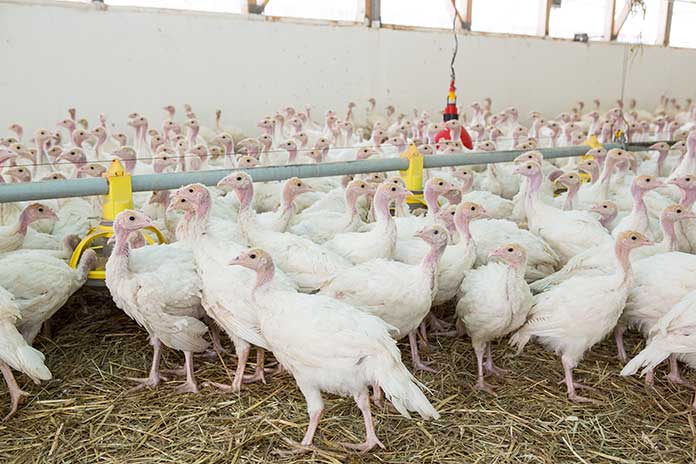
Lameness and poor footpad condition can be major issues for meat-type poultry resulting in their decreased well-being and decreased productivity. A large body of research exists for footpad dermatitis (FPD) in broilers and a smaller subset related to turkeys.
While both broilers and turkeys can develop footpad dermatitis, there are species differences in the prevalence and severity as well as differences in the production cycle. Turkeys appear to have a higher incidence and greater severity of FPD in comparison to broilers. On a 3-point scale, broilers peaked with a foot pad score of 0.25 while turkeys peaked with a score of 2.0. In 2002, using the 5-point scale and assessed at the time of processing, the average score for toms and hens in US industry was 2.8 and 2.6, respectively. For 2013, scores taken at processing for toms averaged 2.6. For light hen and heavy hens, FPD scores averaged 2.5 and 2.96, respectively (personal communication, Greg Hansen, CEO, Intellimetrics). The data suggest that average scores for toms in the US have stayed the same, improved slightly for the light hen, and are more severe for the heavy hen.
Surveys for prevalence and incidence at the farm level for different ages of turkeys are not publicly available for the US turkey industry except for a survey of commercial tom flocks near market; however, data specific to prevalence was not available.
Prevalence data from European turkey flocks have been primarily collected at processing indicating a high prevalence of FPD with moderate to severe lesions based. A few of these studies monitored the condition on the farm and indicated a high prevalence of FPD in young turkeys during brooding.
Several factors have been previously identified as involved in FPD development including bedding type as related to particle size and moisture uptake, litter moisture, drinker design and management, litter depth, stocking density, and season. Grain sources and plant protein sources as soybean meal result in viscous droppings due to presence of indigestible carbohydrates and adhere to the foot pad.
Increased stocking density in particular was a key factor associated with a rapid decline in litter quality associated with increased water intake by the broilers. The common link among all these factors is the interaction of the footpad with the mixture of bedding and excreta especially in relation to deposition of moisture in the litter through the excretory system or through other environmental means.
As
in broilers, increased litter moisture is associated with FPD development in
turkeys. A significant body of work has been put together by researchers in the
UK as well as earlier research by Martland et al. (1984) for turkeys.
The UK experimental model induces FPD in a 6 day time frame by keeping litter
moisture at 70%. Litter is described as being soggy or very wet. In another
study of FPD and adding moisture to the litter, foot pad score was minimized
when litter moisture was less 30% and when turkeys of different ages were
placed on wet litter (70% moisture), there did not appear to be an age
susceptibility to development of FPD.
An inter-relationship of bedding material and stocking density of market turkey hens on foot pad dermatitis was demonstrated recently. A study was conducted to investigate the effects of turkey hen density (low (LD), medium (MD), and high stocking density (HD) of 4.2, 5.3 and 7 hens/m2) and two bedding (B) materials (pine shavings, PS and giant miscanthus grass, MG) in a factorial arrangement on severity and prevalence of FPD in turkey hens. The study was conducted at Penn State University where Hybrid poults (1056) were placed into 24 pens for rearing. At 14 weeks of age, a composite footpad score (FPS) (increasing severity 0, 1 or 2) for each hen in the study was obtained without cleaning the pads.
At 14 weeks, FPS averaged 1.1 and the prevalence of hens with scores of 0, 1, and 2 was 21, 51, and 28%, respectively. Hens reared on MG had higher FPS compared to those on PS (1.43 vs 0.71). As D increased, FPS increased from 0.77 to 1.27 at highest D. The effect of D on the prevalence of hens with a zero FPS was dependent on bedding type. The proportion of hens reared on PS with zero FPS was 69, 30 and 19% at 4.2, 5.3 and 7 hens/m2, respectively, while for hens reared on MG, no difference was detected among D (7, 0.6, and 0.5% prevalence of 0 at 4.2, 5.3 and 7 hens/m2, respectively).
Litter moisture at 14 weeks of age was greater for MG as compared to PS (49% vs 56%) and litter moisture increased as stocking density increased (48.4, 51 and 57.6% for LD, MD, and HD, respectively). The lowest measured litter moisture was 44% for hens reared at LD and on pine shavings. A Relatively small increase in litter moisture reduced the prevalence of zero FPS in pine shavings as result of increasing litter moisture due to increasing moisture content (44, 47.5, and 55% litter moisture at LD, MD, and HD, respectively). For MG, the litter moisture increased from 52 to 55 to 60% with increasing stocking density.
The results indicated that small increases in litter moisture greatly increased footpad severity scores in market turkey hens assessed at 14 weeks of age. Bedding material modified the footpad score, with litter moisture in excess of 52% resulting in a majority of turkeys having footpad lesions.
References are available on request
From the Proceedings of 2019 Midwest Poultry Federation Convention
















